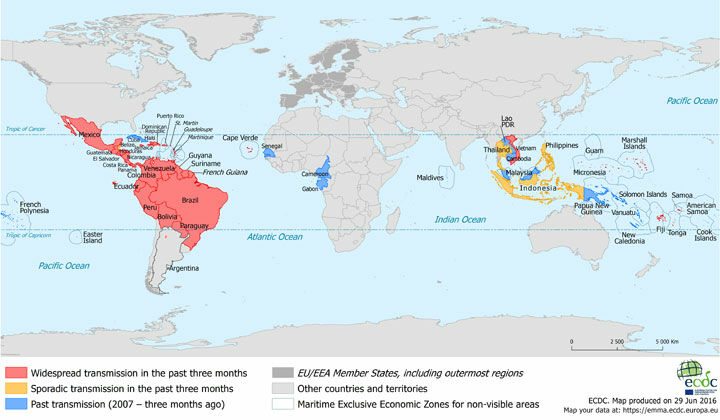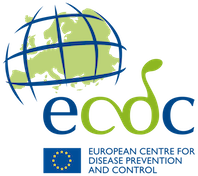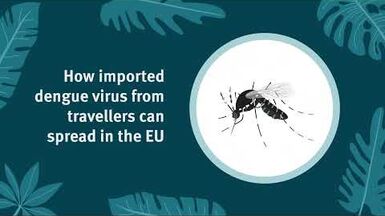Epidemiological update: Outbreaks of Zika virus and complications potentially linked to the Zika virus infection, 30 June 2016
During the past week, no new country or territory has reported mosquito-borne Zika virus transmission.
New developments since the last epidemiological update
During the past week, no new country or territory has reported mosquito-borne Zika virus transmission. In the USA, the Florida Department of Health confirmed the first Zika-related case of microcephaly in a child born in Florida whose mother had a travel-related case of Zika. The mother, a citizen of Haiti, came to Florida to deliver her baby.
Table 1. Countries and territories with reported confirmed autochthonous cases of Zika virus infection in the past three months, as of 1 July 2016
| Countries | Last case since 3 months |
|---|---|
| American Samoa | Widespread transmission |
| Anguilla | Sporadic transmission |
| Argentina | Widespread transmission |
| Aruba | Widespread transmission |
| Barbados | Widespread transmission |
| Belize | Sporadic transmission |
| Bolivia | Widespread transmission |
| Bonaire | Sporadic transmission |
| Brazil | Widespread transmission |
| Cape Verde | Widespread transmission |
| Colombia | Widespread transmission |
| Costa Rica | Widespread transmission |
| Curaçao | Widespread transmission |
| Dominica | Widespread transmission |
| Dominican Republic | Widespread transmission |
| Ecuador | Widespread transmission |
| El Salvador | Widespread transmission |
| Fiji | Widespread transmission |
| French Guiana | Widespread transmission |
| Grenada | Sporadic transmission |
| Guadeloupe | Widespread transmission |
| Guatemala | Widespread transmission |
| Haiti | Widespread transmission |
| Honduras | Widespread transmission |
| Indonesia | Sporadic transmission |
| Jamaica | Widespread transmission |
| Marshall Islands | Widespread transmission |
| Martinique | Widespread transmission |
| Mexico | Widespread transmission |
| Micronesia, Federated States of | Widespread transmission |
| Nicaragua | Widespread transmission |
| Panama | Widespread transmission |
| Paraguay | Widespread transmission |
| Peru | Widespread transmission |
| Philippines | Sporadic transmission |
| Puerto Rico | Widespread transmission |
| Saint Lucia | Widespread transmission |
| Saint Martin | Widespread transmission |
| Saint Vincent and the Grenadines | Widespread transmission |
| Saint-Barthélemy | Widespread transmission |
| Samoa | Widespread transmission |
| Sint Maarten | Widespread transmission |
| Suriname | Widespread transmission |
| Thailand | Sporadic transmission |
| Tonga | Widespread transmission |
| Trinidad and Tobago | Widespread transmission |
| US Virgin Islands | Widespread transmission |
| Venezuela | Widespread transmission |
| Vietnam | Widespread transmission |
EU/EEA and EU Outermost Regions and Territories
Since week 45/2015, ten countries (Belgium, Czech Republic, Denmark, Finland, France, Italy, Malta, Slovenia, Spain and the UK) reported 783 travel-associated Zika virus infections through The European Surveillance System.
As of 30 June 2016, ECDC has detected 929 imported cases through Epidemic Intelligence activities. This information is aggregated from official EU/EEA public health authorities websites but is not based on a systematic reporting surveillance system hence cannot be considered exhaustive.
EU’s Outermost Regions and Territories:
As of 30 June 2016:Guadeloupe: 17 820 suspected cases have been detected, an increase of 2 620 suspected cases since last week. The weekly number of cases is not decreasing yet. French Guiana: 8 450 suspected cases have been detected, an increase of 380 since last week. The weekly number of cases has been increasing compared to the previous three weeks. Martinique: 31 760 suspected cases have been reported, an increase of 790 since last week. The weekly number of cases has been stable over the last four weeks. St Barthélemy: 130 suspected cases have been detected, an increase of 25 suspected cases since last week. The weekly number of cases is still increasing.
St Martin: 1 095 suspected cases have been detected, an increase of 110 suspected cases since last week. The weekly number of cases has decreased compared to the previous week.
Update on microcephaly and/or central nervous system (CNS) malformations potentially associated with Zika virus infection
As of 29 June 2016, microcephaly and other central nervous system (CNS) malformations associated with Zika virus infection or suggestive of congenital infection have been reported by thirteen countries or territories. In the EU, Spain (2) and Slovenia (1) reported congenital malformations associated with Zika virus infection after travel in the affected areas. Cases have also been detected in the EU’s Outermost Regions and Territories in Martinique, French Guiana and French Polynesia. Fourteen countries and territories worldwide reported an increased incidence of Guillain-Barré syndrome (GBS) and/or laboratory confirmation of a Zika virus infection among GBS cases. Brazil: Between October 2015 and 30 June 2016, Brazil has reported 8 165 suspected cases of microcephaly and other nervous system disorders suggestive of congenital infection; this is an increase of 229 cases since the last update; 1 638 are confirmed cases of microcephaly, 270 of which are laboratory-confirmed for Zika virus infection.
Figure 1. Countries or territories with reported confirmed autochthonous cases of Zika virus infection in the past three months, as of 29 June 2016

All ECDC maps with information on countries or territories with reported confirmed autochthonous cases of Zika virus infection can be found here.




